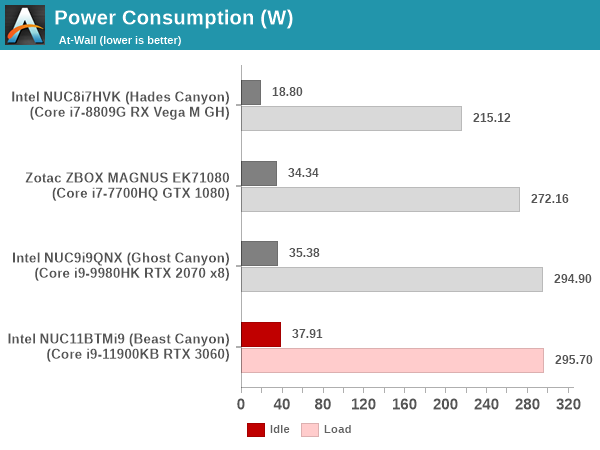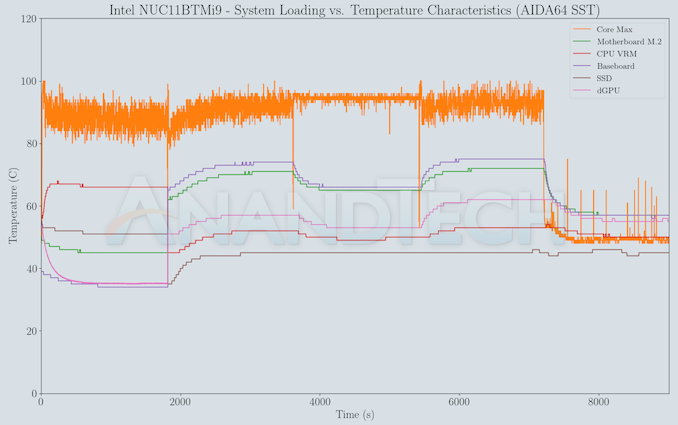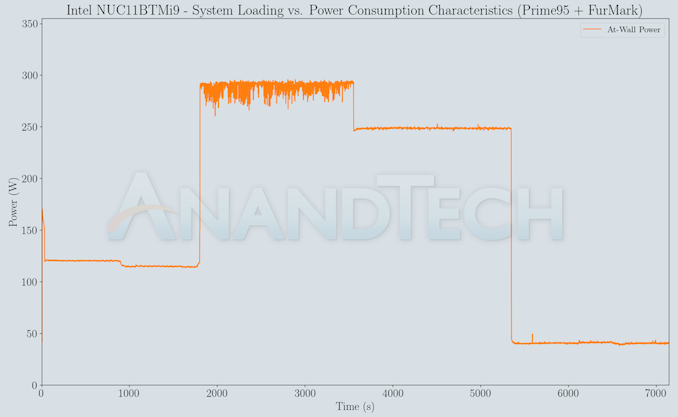Intel Beast Canyon NUC Review: Desktop Tiger Lake Debuts in SFF Gaming Powerhouse
by Ganesh T S on July 29, 2021 9:00 AM EST- Posted in
- Systems
- Intel
- NUC
- Tiger Lake
- NUC11
- Beast Canyon
Power Consumption and Thermal Performance
The power consumption at the wall was measured with a 4K display being driven through the HDMI port of the discrete GPU. In the graphs below, we compare the idle and load power of the Intel NUC11BTMi9 (Beast Canyon) with other similar PCs evaluated before. For load power consumption, we ran the AIDA64 System Stability Test with various stress components, as well as the artificial power virus test involving Prime95 and Furmark. The maximum sustained power consumption at the wall was recorded.

The numbers are very similar to the ones obtained for the Ghost Canyon NUC.
Our thermal stress routine starts with the system at idle, followed by four stages of different system loading profiles using the AIDA64 System Stability Test (each of 30 minutes duration). In the first stage, we stress the CPU, caches and RAM. In the second stage, we add the GPU to the above list. In the third stage, we stress the GPU standalone. In the final stage, we stress all the system components (including the disks). Beyond this, we leave the unit idle in order to determine how quickly the various temperatures in the system can come back to normal idling range. The various temperatures and power consumption number for the system during the above routine are presented in the graphs below.
While the CPU package manages to stay below the junction temperature during the system stability test, it does hover very close to the limits. This is likely due to the fans not taking effect soon enough, as the BIOS tries to maintain a balance between noise levels and cooling efficiency. It is likely that the production BIOS will need to sacrifice some noise levels for better thermals. Despite significant loading on the SSD, the thermal solution is good enough to keep the temperature below 75C.
A similar test routine is conducted with Prime95 running in maximum power consumption mode for 30 minutes, followed by the addition of a FurMark stress workload for another 30 minutes. After a cumulative run time of a hour, the Prime95 workload is removed, and FurMark allowed to proceed for another 30 minutes. The system is then left idle for another half an hour. The metrics tracked in the AIDA64 SST case are also tracked here.
The artificial power virus test significantly amps up the power consumption when both Prime95 and Furmark are simultaneously active. The GPU temperature is also a bit toasty and seems to suffer some after-effects of the Furmark loading. However, the core temperature quickly falls down to around 50C, thanks to the well-ventilated chassis and the three fans on the top panel.














84 Comments
View All Comments
vol.2 - Tuesday, August 3, 2021 - link
SFF = SMALL form factorIntel's marketing literature was pretty specific about it. Sure, they can change what NUC means by turning into a generic smallish PC device similar to Micro ATX, but that genericizes the NUC to the point where it just becomes Intel's brand for a form factor that already exists.
mode_13h - Wednesday, August 4, 2021 - link
> but that genericizes the NUC to the point where it just becomes Intel's brandYes, Intel is a pro at taking a naming scheme that has some logic to it, and then twisting it into something meaningless. Like, the i3/i5/i7 naming scheme, for instance. On some of their laptop chips, like the U-series Skylakes, they had exactly the same core-count and thread-count, differing only in a few hundred MHz of clock speed.
Hey, if marketing simply came up with a logical naming scheme and sticking to it, how would they "add value"? Marketing is always looking for a way to gin up sales, in the next quarter or FY.
mode_13h - Wednesday, August 4, 2021 - link
Remember, we're talking about the same Intel that changed their Xeon processors from using the E3/E5/E7 naming scheme to E/W/Silver/Gold/Platinum, back in 2017!mode_13h - Sunday, August 1, 2021 - link
> Intel are clearly moving the goalposts here on what a NUC form factor should beSo far, the lineup is:
* NUC Essential
* NUC
* NUC Pro
* NUC Extreme
I expect further up-range models will be:
* NUC Insane - HEDT CPU + dual GPU + water cooling
* NUC Ridiculous - dual CPU + quad-GPU + external radiator
willis936 - Thursday, July 29, 2021 - link
Now make it with ECC :)Jorgp2 - Thursday, July 29, 2021 - link
Buy one with ECCwillis936 - Thursday, July 29, 2021 - link
I would if the chipsets of CPUs from anytime in the past two years were available.AdrianBc - Thursday, July 29, 2021 - link
The previous Ghost Canyon had a variant with a mobile Xeon and ECC memory.It was very nice, except for 2 problems.
It was introduced one year too late, when Coffee Lake Refresh was already too obsolete and it was overpriced by about $500 compared with a standard desktop with similar features.
For this one, no version with a Xeon has been announced and there were no rumors about such a version.
dullard - Thursday, July 29, 2021 - link
I'm curious what niche use case needs a moderately small computer, but not too small, with video card, and ECC.AdrianBc - Thursday, July 29, 2021 - link
There are people like myself, who do not accept to use a computer without ECC in any circumstance. So, except for my mobile phone, I do not use any computer without ECC, neither as a laptop, nor as a desktop nor as a SFF computer and of course not as a server.Any computer without ECC is just a toy, guaranteed to have errors from time to time, which should be used only in game consoles or similar applications.
The fact that the computers without ECC are not a small niche is sad and this just shows how many people are so gullible that they will believe whatever a vendor says that is good for them.